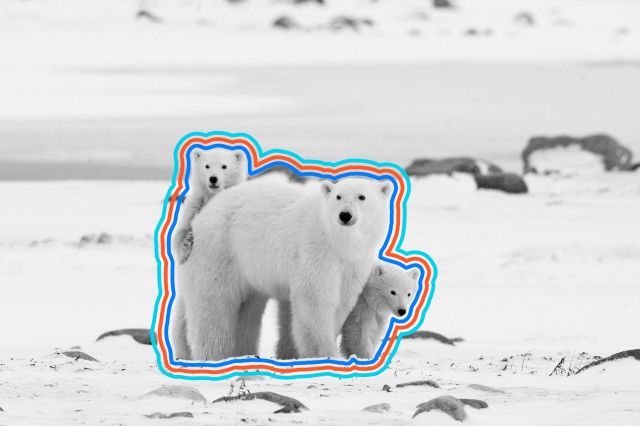
The Position of the Arctic Circle Changes Every Year
The Arctic Circle is located at approximately 66.3 degrees north of the equator; however, its actual location changes slightly every year. This is due to the fluctuation of Earth’s axial tilt, which is influenced by the orbit of the moon and the consequent tidal changes. The same axial tilt causes the different seasons that we experience on Earth. Currently, the circle is moving north at a rate of around 49 feet per year. In 2017, an art exhibit called Orbis et Globus was inaugurated on Iceland’s Grimsey Island to monitor the circle’s movements.

Earth’s Largest Land Predators Are Unique to the Region
Polar bears are the largest land carnivores in the world, and they are only found in the Arctic region. They reside around ice-covered waters and are dependent on sea ice for food, to rest, and to breed. Fully grown male polar bears measure around eight to nine feet from nose to foot, while females measure approximately six to seven feet. Despite their enormous size, polar bears are only about the size of a guinea pig when born. These cuddly-looking bears feed mainly on seals, are talented swimmers, and possess a coat of white fur (although it’s actually transparent) to camouflage themselves in their snowy habitats.

The Arctic Name Is a Reference to the Greek Word for Bear
Appropriately, the word “arctic” itself is derived from the Greek word arktos, which means “bear.” However, the bear in reference isn’t the polar variety, but instead the celestial kind, specifically the Ursa Major (Great Bear) and Ursa Minor (Little Bear) constellations. Both of the constellations are visible from the Northern Hemisphere, and the latter contains the North Star. At the opposite end of the world, Antarctica gets its name because those constellations aren’t visible from that region. Interestingly enough, there are also no animal bears in Antarctica.
More Interesting Reads

Over 4 Million People Live Within the Arctic Circle
The Arctic Circle incorporates portions of eight countries: Canada, Greenland, Iceland, Norway, Finland, Russia, Sweden, and the United States. And despite a harsh climate and often inhospitable living conditions (for most), an estimated 4 million people live and work there year-round. Murmansk, in northwestern Russia, is the largest and one of the oldest settlements in the Arctic Circle. This city on the Barents Sea is home to around 300,000 residents and is known for its seaports and naval bases. In fact, eight of the 10 largest Arctic settlements are located in Russia.

Dozens of Indigenous Groups Thrive in the Region
Residing among the large population of the Arctic Circle are over 40 different ethnic groups, such as the Inuit, Saami, and Yupik peoples. They account for 10% of the regional population. While they vary greatly in culture, language, and history, these Indigenous groups have a strong connection to the arctic lands they’ve inhabited for thousands of years. Many maintain traditional fishing, reindeer herding, and hunting activities, but their livelihoods and productivity are under threat from dramatic weather changes and disappearing sea ice.

It’s Home to the Largest Seed Storage Facility in the World
Set amid the frigid waters between Greenland and Norway is the Norwegian island of Svalbard. Here, the Norwegian government opened the Svalbard Global Seed Vault, which is the world’s largest secure seed storage, in 2008. This 10,764-square-foot vault is buried almost entirely into the island’s permafrost — only the concrete entrance is visible to the outside world, and only scientists and staff are allowed inside. The structure has the capacity to store 4.5 million different seed types and maintains them at constant temperatures of 37.4 to 39.2 degrees Fahrenheit. The collection is stashed here for safekeeping in case of crop failures or natural disasters — because of its naturally stable Arctic climate, and also since it’s one of the least likely places on Earth to experience either a flood or a heat wave, both of which could damage the seeds.

Four U.S. National Park Sites Lie Within the Arctic Circle
Alaska is home to 54 million acres of land protected under the U.S. National Park Service, representing about two thirds of the land in the entire system. Four of the state’s national park units are situated inside the Arctic Circle: Cape Krusentern National Monument, Gates of the Arctic National Park and Reserve, Kobuk Valley National Park, and Noatak National Preserve. Visitors to these parks and reserves have the chance to discover untamed wildernesses made up of glaciated valleys, rivers, and lagoons framed by soaring mountain ranges. There are also opportunities to spot caribou and grizzly bears and to experience days of extreme daylight and darkness.

There Are Actually Four North Poles Located in the Arctic Circle
For many, the North Pole is often associated with Santa Claus, flying reindeer, and toy-making elves. What most don’t know is that there are actually four recognized North Poles. The Geographical North Pole (aka True North) is the northernmost point on the planet and where all of Earth’s lines of longitude meet. The Magnetic North Pole is the spot at which the planet’s lines of magnetic force all point vertically downward (and the point that attracts the needle of a compass). The Geomagnetic North Pole is the northern end of where the axis of the magnetosphere — the magnetic field that surrounds the Earth and extends into space — intersects the planet. Finally, the North Pole of Inaccessibility is the point in the Arctic Ocean that’s furthest from any coastline.

A Cartoonist Invented Santa’s North Pole Home
In the mid-1800s, German-born American artist Thomas Nast made a name for himself for his caricatures and political cartoons. He’s also credited with creating the popular image of Santa Claus (or Father Christmas). In 1863, Harper’s Weekly magazine published two of his illustrations that depicted Santa as a larger-than-life character with a long beard and stocking cap. One of the images was inscribed with the words “Santa Clausville, N.P.” The N.P. was an abbreviation of North Pole, and so began the myth of Santa residing in a far-off and remote northern land.











